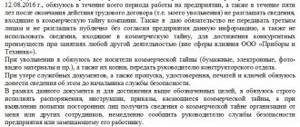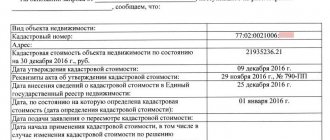Why do they sign?
A corporate secret is information that is of particular value to the organization, allows it to operate effectively in the market, make a profit, minimize costs, and avoid losses. Any information other than those listed in Article 5 of Federal Law No. 98-FZ is recognized as a corporate secret. For example, the following cannot be considered secret:
- information about the number of employees of the organization and their working conditions;
- information about offenses committed or being committed by the company;
- information about environmental pollution arising in connection with the organization’s activities.
To maintain the trade secret regime, they sign a non-disclosure agreement with the employee or partner organization. The non-disclosure requirement applies to everyone to whom the information has become available: disclosure will be held accountable, and the culprit will pay compensation for losses that arose because of this. The agreement is drawn up as a separate document or as a clause on non-disclosure of trade secrets in an employment contract - simultaneously with hiring, the employee assumes the obligation to store information received from the new employer.
If an employer obliges an employee to sign a non-disclosure agreement, he is obliged to officially familiarize him with all documents relating to the established regime: regulations on the regime, a list of classified information and instructions for handling documents containing it.
Adoption of a trade secret provision
An agreement on non-disclosure of trade secrets is signed between the employee and the employer, which cannot contradict existing provisions and federal law. Lawyers will help you develop an agreement taking into account all legal norms.
The regulation stipulates not only the obligations of employees to maintain secrets and confidential information, but also the responsibility that bears both the employer and the employee. Responsibility for disclosure of trade secrets within the framework of federal law is determined as disciplinary or civil, as well as administrative or criminal, depending on the degree of violations and damage caused.
It is noteworthy that if the information comes into the use of a third party who does not know that it is a trade secret and uses it, this person cannot be held liable. That is why it is not enough to simply develop documentation and regulations on the protection of trade secrets; it is also necessary to develop a mechanism for protecting this information.
Experienced lawyers will help at all stages of this process. The regulation specifies all aspects of protection, and it is the regulation that the manager refers to when concluding agreements on non-disclosure of trade secrets.
Who signs
The non-disclosure agreement is bilateral:
- On the one hand, the employee participates in it. Only those whose work is related to corporate secrets and who inevitably learn them sign a sample trade secret agreement with an employee;
- on the other side is the employing company. On her behalf, the document is signed by a manager: general director, director, chairman or head of a department. Either another authorized employee of the organization who performs the duties of a manager, is appointed to the position of manager of an order, or an employee who has been issued a power of attorney from a legal entity to sign such documents has the right to sign it.
Trade secrets in contractual documentation
Article 10. Protection of confidentiality of information
1. Measures to protect the confidentiality of information taken by its owner must include:
1) determination of the list of information constituting a trade secret;
2) restricting access to information constituting a commercial secret by establishing a procedure for handling this information and monitoring compliance with such a procedure;
3) accounting of persons who gained access to information constituting a trade secret and (or) persons to whom such information was provided or transferred;
4) regulation of relations regarding the use of information constituting a trade secret by employees on the basis of employment contracts and contractors on the basis of civil law contracts;
5) affixing on tangible media containing information constituting a trade secret, or including in the details of documents containing such information, the stamp “Trade secret” indicating the owner of such information (for legal entities - full name and location, for individual entrepreneurs – last name, first name, patronymic of a citizen who is an individual entrepreneur, and place of residence).
2. The trade secret regime is considered established after the owner of information constituting a trade secret takes the measures specified in Part 1 of this article.
3. An individual entrepreneur who is the owner of information constituting a trade secret and does not have employees with whom employment contracts have been concluded, takes measures to protect the confidentiality of information specified in part 1 of this article, with the exception of paragraphs 1 and 2, as well as the provisions of paragraph 4 relating to the regulation of labor relations.
4. Along with the measures specified in Part 1 of this article, the owner of information constituting a trade secret has the right to use, if necessary, means and methods of technical protection of the confidentiality of this information, and other measures that do not contradict the legislation of the Russian Federation.
5. Measures to protect the confidentiality of information are considered reasonably sufficient if:
1) access to information constituting a trade secret by any persons without the consent of its owner is excluded;
2) it is possible to use information constituting a trade secret by employees and transfer it to counterparties without violating the trade secret regime.
How to compose correctly
The law does not provide a unified form for an agreement on trade secrets with an individual. It is recommended that the document reflect the following points:
- subject: the employee’s obligation not to disclose secret information entrusted to him. You should indicate a list of protected information or provide a link to the document where this list is established;
- rights and obligations of the parties: the employee is obliged to use classified information in a strictly defined manner and comply with the rules for handling documents containing secret data. The organization is obliged to provide the employee with the necessary working conditions that allow him to work with trade secrets;
- liability for disclosure of secrets: the employee will compensate in full for losses incurred by the organization in connection with the disclosure.
How to draw up a non-disclosure agreement for trade secrets?
A non-disclosure agreement on trade secrets is concluded after signing an employment contract, or it is better to conclude it simultaneously with the employment contract. The contract in question must actually contain the same information as the employment contract, i.e. about the parties to the agreement, details of the parties, about the place and date of conclusion of the agreement, must be signed by the parties.
When drawing up a contract, the following points must be reflected:
- subject of the contract , which includes provisions that the employee undertakes not to disclose information constituting a trade secret, the list of which is specified in the provision on trade secrets or other document. ATTENTION: in the subject of the contract you can list all the information that relates to a trade secret.
- rights and obligations of the parties to the contract , which may reflect how the information is to be used, how the employer will provide access to such information, etc.
- employee liability for disclosure of trade secrets.
- The contract may also include a section on the procedure for making changes to the contract, on the procedure for resolving disputes that have arisen, on the duration of the obligation not to disclose trade secrets, etc.
TIP : specify the validity period of the employee’s obligation not to disclose trade secrets, for example, for 5 years after dismissal.
The employer may not enter into a separate agreement so that trade secrets are not disclosed by the employee, but include the relevant provisions in the employment contract, or formalize it in another document as indicated above.
REMEMBER : you cannot include provisions in the contract that limit the rights of the employee, for example, a provision that after dismissal the employee does not have the right to get a job with the organization's competitors; a legal analysis of the drafted contract can be carried out by our lawyer
Design features
It is recommended to include the following sections in the agreement on the transfer of corporate secrets and mutual protection of each other’s information between legal entities:
- subject: the obligation of both parties to preserve each other’s information, it is necessary to indicate a list of protected information;
- obligations of the parties: to use secret data received from the counterparty only within the framework of the implementation of a joint agreement or project, to take care of non-disclosure of information to third parties;
- liability of the parties for violation of the secrecy regime;
- the period during which the parties must keep the information received secret: during the term of the agreement itself and for some time after its expiration or termination;
- additional conditions: validity period of the agreement, number of copies, language of the agreement, details of the parties.
There is no required form for non-disclosure documents.
Responsibility for disclosure of trade secrets
The trade secret regime is a special regime under which the parties to the non-disclosure agreement are liable for violation of this agreement. If state or municipal authorities require the provision of information that constitutes a trade secret, they are also responsible for disclosing this information to third parties.
Liability for violation depends on the extent of damage caused to the company. For example, if a company loses income during the disclosure, the violator may be subject to criminal liability with compensation for lost profits.
The protection of documents containing trade secrets falls entirely on the shoulders of the company's director. In order for information to be reliably protected, the assistance of lawyers is required who can fully support the process of preparing documentation and protection mechanisms.
Mandatory requirements for drawing up a non-disclosure agreement
At the legislative level, a standard, unified sample of a non-disclosure receipt has not been established, therefore it is allowed to be issued in any form in compliance with the following necessary details:
- Company name;
- date, place of drawing up the receipt;
- document's name;
- personal data of the employee indicating the full name, details (number, date) of the employment contract;
- employee non-disclosure obligations;
- the period during which information is not subject to disclosure, including after the employee’s dismissal.
The receipt has no restrictions on the volume of text, however, following the recommendations of legal specialists, it must be carefully developed, since in the event of a violation of the employee’s obligation, the receipt of non-disclosure of information can serve as indisputable evidence when presented in court.
Therefore, it is recommended to provide in the text of the receipt the obligation of the employee, in the event of termination of the employment contract, to transfer the confidential information he has in the form of paper or electronic media to the responsible person, as well as to provide for liability in accordance with established legislation in case of violation of the obligations assumed.
It is allowed to issue a receipt directly by the employee, by hand or in printed form, using a regular sheet of A4 paper or the organization’s letterhead. At the same time, a mandatory requirement for this type of documentation is the presence of an original signature of the employee with a transcript of his position and surname.
The receipt is drawn up in a single copy and is included in the documents stored in the personal file of the company employee. The validity period of the receipt is, as a rule, the duration of the employee’s work in a particular company, with the addition of several years from the date of termination of the employment contract (dismissal), determined on an individual basis.
In addition, among the common documents drawn up in order to protect confidential information is a bilateral agreement signed by the employer and employee, containing the same details and data as a unilateral non-disclosure agreement, as well as the inclusion of conditions for the preservation of materials, related to trade secrets, in the text of the employment contract with the employee.
Example of a non-disclosure agreement







